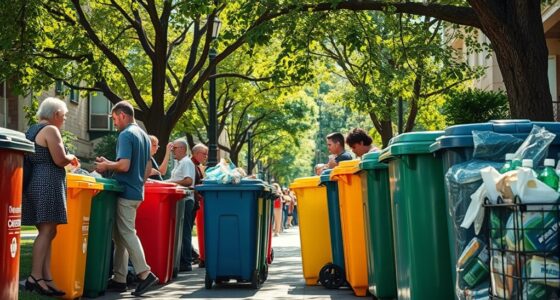Implementing rainwater harvesting in your city can turn heavy storms into a valuable resource, easing your area’s drainage system and reducing flooding risks. By capturing rain from rooftops and directing it into storage tanks or permeable surfaces, you help conserve water, lower utility costs, and promote sustainability. This approach boosts your community’s resilience to droughts and fosters greener urban spaces. Keep exploring to discover how you can make these benefits a reality in your city.
Key Takeaways
- Urban rainwater harvesting reduces municipal water demand and alleviates stormwater runoff, preventing flooding and infrastructure stress.
- Installing rooftop collection systems and permeable pavements turns storms into a sustainable water resource.
- Scaled rainwater harvesting enhances urban water management, promotes groundwater recharge, and lowers environmental impact.
- Green roofs and rain gardens integrate stormwater control into city planning, boosting resilience to droughts and climate change.
- Community engagement and affordable techniques foster a culture of water conservation, transforming storms into savings and environmental benefits.

Have you ever considered how rainwater harvesting can transform urban living? In cities where space is limited and water resources can be strained, capturing rainwater offers a practical and sustainable solution. This approach directly impacts urban infrastructure by reducing the burden on municipal water systems and easing stormwater runoff, which often overwhelms drainage systems during heavy rains. By integrating rainwater harvesting into city planning, communities can enhance their water conservation techniques, making neighborhoods more resilient to droughts and water shortages.
Implementing rainwater harvesting in urban areas is more straightforward than you might think. Small-scale systems, such as rooftop collection, can be installed on homes, commercial buildings, and public spaces. These systems typically involve gutters directing rainwater into storage tanks, which can then be used for non-potable purposes like irrigation, flushing toilets, or cleaning. Not only do these setups help conserve potable water, but they also decrease the volume of stormwater entering city drainage, mitigating flooding risks. As you adopt these water conservation techniques, you’re actively participating in easing the strain on city infrastructure that often struggles with capacity during heavy storms.
Installing rooftop rainwater collection tanks helps conserve water and reduces urban flooding risks.
You might wonder how effective rainwater harvesting truly is in a bustling city. The truth is, when scaled appropriately, it can profoundly impact urban water management. Cities can incentivize the installation of rain gardens, permeable pavements, and green roofs—each a form of water conservation technique that allows rainwater to soak into the ground rather than overwhelming sewer systems. These measures help replenish groundwater and reduce surface runoff, improving overall urban resilience. Additionally, by promoting rainwater harvesting, city planners can create more sustainable neighborhoods that rely less on distant water sources, lowering costs and environmental impacts.
As you become more aware of urban infrastructure’s vulnerabilities, you’ll see rainwater harvesting as a crucial part of city resilience. It’s an accessible, cost-effective way to conserve water and manage stormwater intelligently. Furthermore, integrating these systems into new developments or retrofitting existing buildings can foster a culture of sustainability. Your participation in this movement doesn’t just save money; it supports the broader goal of building smarter, greener cities. By adopting simple water conservation techniques and encouraging their use, you help turn storms into a resource rather than a problem. It’s an empowering step toward a more sustainable urban future, where every rainfall becomes an opportunity for savings and environmental stewardship. Incorporating rainwater harvesting into city planning can also promote community awareness and engagement in water conservation efforts.
Frequently Asked Questions
What Permits Are Required for Urban Rainwater Harvesting Systems?
You need to check your local zoning regulations and plumbing codes before installing an urban rainwater harvesting system. Permits are often required to guarantee your setup meets safety and environmental standards. You might need approval from city or county authorities, especially if you’re connecting to your home’s plumbing or making structural changes. It’s best to consult local agencies early, so you avoid fines or delays in creating a sustainable, compliant rainwater collection system.
How Much Does Installing a Rainwater Harvesting System Typically Cost?
Ever wonder what it costs to turn stormwater into savings? A typical rainwater harvesting system’s cost estimate varies, but you should expect installation expenses to range from $2,000 to $10,000 or more. Factors like system size, materials, and complexity influence the price. Investing now could pay off later, helping you conserve water and reduce bills—so don’t wait to explore your options and get personalized quotes.
Are There Any Health Risks Associated With Using Collected Rainwater?
When you use collected rainwater, you should be aware of water quality and contamination risks. If your system isn’t properly maintained, bacteria, algae, or pollutants can enter, posing health risks. To mitigate these risks, regularly clean your catchment surfaces, filters, and storage tanks. Using appropriate treatment methods, like boiling or filtering, ensures safe water quality, helping you enjoy the benefits without compromising your health.
How Long Does It Take for a Rainwater Harvesting System to Pay for Itself?
Imagine planting a seed that grows into savings; a rainwater harvesting system can do just that. You’ll need to do a cost analysis considering installation and ongoing maintenance requirements. Typically, it takes 2 to 7 years for the system to pay for itself through reduced water bills. Regular maintenance guarantees efficiency, helping you reap the benefits sooner and turn storms into a steady source of savings.
Can Rainwater Harvesting Reduce Urban Flooding and Drainage Issues?
You can reduce urban flooding and drainage issues by implementing rainwater harvesting systems. These systems help manage stormwater runoff, decreasing the volume of water that overwhelms city drainage. As you collect rainwater, you lessen the burden on urban stormwater management infrastructure, preventing flooding during heavy storms. By capturing and reusing rainwater, you also promote sustainable water use, making your city more resilient to extreme weather events.
Conclusion
By embracing rainwater harvesting, you turn stormy challenges into steady savings, much like a city transforming a sudden downpour into a nourishing stream. Imagine one neighborhood collecting just 10% of rainwater—reducing municipal water use by thousands of gallons annually. Your efforts can be the difference between letting storms go to waste and making them work for you. With each drop you capture, you’re not just saving water—you’re nurturing a more resilient, sustainable city for everyone.










